Samsung Galaxy Z Fold 5 Review—The Best Foldable Costs Too Much
Over the past year of using Samsung’s Galaxy Z Fold 4 out in public, people have told me that, while they think folding phones are cool, they seem like nothing more than an expensive party trick. I don’t disagree. Life is fine with just one screen in your pocket and a smartphone that doesn’t unfold into a tablet. No one needs this much device on them at all times, especially one that’s so much bulkier than a regular smartphone.
And yet, I can’t help but be elated over the minuscule progress Samsung’s made with this generation’s book-like foldable, the Galaxy Z Fold 5. The Z Fold 5’s gains are minor compared to its predecessors, but things are clearly improving for the folding subset. The Z Fold 5 boasts a new type of hinge technology from Samsung, which helped cut down on some of the thickness, making the phone more comfortable to hold one-handed. Samsung’s Dynamic AMOLED displays are still the most vibrant for consuming content. And although Google has joined the race with its Pixel Fold, it is Samsung’s folding interface that’s still the one to beat.
Whether the Z Fold 5 is worth at least $1,800 without a trade-in remains a personal choice, as that is still too much to spend on any smartphone. But in its fifth generation, the Galaxy Z Fold 5 has officially entered the “leading edge” for what other book-like foldables should feature going forward.
What is the Z Fold 5 hinge like?
On paper, Samsung’s Galaxy Z Fold 5 is a stellar package—it has to be since its starting cost is about as much as a powerful laptop. The Z Fold 5 has a 6.2-inch front cover with a 7.6-inch Dynamic AMOLED display inside. Both displays run at a 120Hz refresh rate, which makes reading and watching a video a smoother experience compared to a 90Hz display like on the Google Pixel 7 or even the Pixel 7a. All the Galaxy flagships have 120Hz displays—so do some of their midrange counterparts—and all the display specifications on the Z Fold 5 are a relatively standard Samsung affair. Even the color tuning is decidedly Samsung. Compared to Google’s Pixel Fold, the AMOLED panel displays more saturated and lively colors than the Fold’s regular OLED.
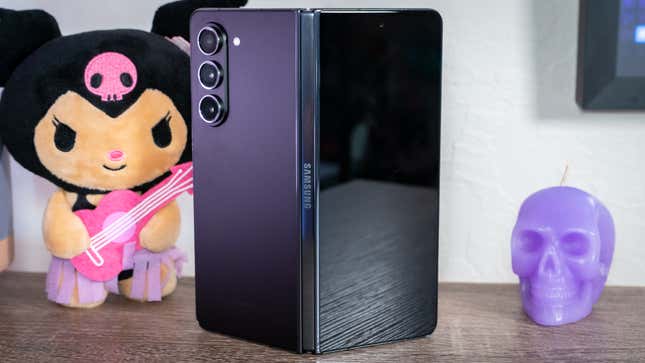
Samsung’s revamped hinge on the Z Fold 5 is called the Flex Hinge. It offers more articulation than before and finally folds flat. The Flex Hinge feels more robust than the previous generations, and the difference in mechanics is immediately noticeable. I’m particularly struck by how quiet the Z Fold 5 is to open compared to its predecessor. After a year of consistent use, the inside of the Z Fold 4 creaks each time I open it up, like an old door that needs greasing. Too bad you can’t oil up a smartphone.
This new hinge eliminates the gap between screens on Samsung’s foldables, which helps the phone feel more balanced when cradling it one-handed. It helps that the Z Fold 5 is about an ounce lighter than the Fold 4, too. It’s a whopping three millimeters thinner, which may not seem like much, but my tiny, foldable-loving hands appreciate any bit that Samsung can shave off so that my wrist isn’t taking the brunt of it.
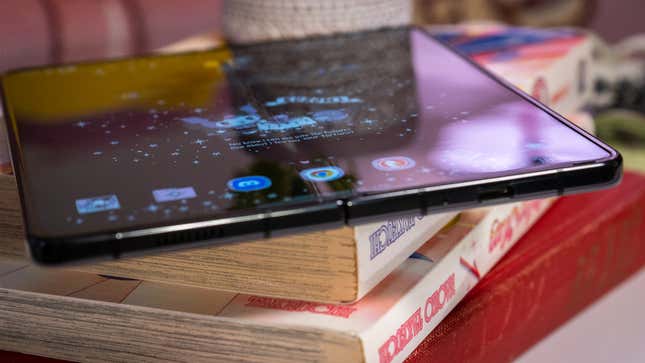
Everything else about the Z Fold 5 remains largely unchanged from the prior Z Fold. There’s a microphone right next to the USB-C charging port on the bottom, opposite the phone’s exhaust vent, and the fingerprint-scanning power button and volume rocker are in the same place they were on the Z Fold 4. The backside is still matte-like, though the three-camera array has slightly changed. The lenses do pop out more than on the Z Fold 4, making it uneven when splayed flat on a table.
I’m still questioning the durability and longevity of these folding devices. Unfortunately, the Z Fold 5 has already suffered a few scratches in my possession from nearby sharp-cornered objects on my desk. And while the Z Fold 5 is IPX8-rated, which makes it resistant to the occasional drops of water, you’ll have to be careful hiking and being out in nature with it in tow. It is not an easy phone to wield when you’re out facing the elements. I especially don’t feel comfortable with the idea of taking this phone to a sandy beach.
Same processor as the Z Fold 4, better battery
Samsung launched its Galaxy S23 flagship devices earlier this year, and rather than reinvent the wheel, its foldables sport similar specifications. The Galaxy Z Fold 5 is powered by the same Samsung-tweaked Qualcomm Snapdragon 8 Gen 2 processor inside the Galaxy S23/S23+/S23 Ultra. Performance benchmarks are on par with the Galaxy S23 Ultra, which includes 12GB of memory like the Z Fold 5. And like the other Samsung devices, it tests better in Geekbench 6 than the Google Tensor G2 CPU, which powers the Pixel Fold.
One obvious change as a result of adopting a folding phone, particularly one meant to be used in tablet mode, is that you may have to adjust how you approach mobile gaming. I still prefer a wrap-around controller like the Razer Kishi on my Pixel 7-sized device because it’s easier to hold. But if you’re down for the phone-on-a-table mobile experience, the large inside screen makes streaming cloud games through Xbox Game Pass and Nvidia GeForce Now seem as native to the Fold 5 as on the big screen. The Z Fold 5 is also great for tablet games like Stardew Valley and Pokemon TCG Live.
The Z Fold 5 has a 4,400 mAh battery pack. It’s technically smaller than the 4,821 mAh battery embedded into Google’s Pixel Fold, but it lasts longer despite the same inside screen size between the two devices. The Galaxy Z Fold 5 lasted 16 hours and 13 minutes in our battery rundown test, which includes streaming a 24-hour long YouTube video at 200 nits of brightness on the screen. The Pixel Fold lasted only 14 hours and 14 minutes, which is about on par with how long last year’s Z Fold 4, with the same battery size, endured in the same benchmark.
The best battery life from a Samsung device is the Galaxy S23 Ultra, which lasted nearly 19 hours with its 5,000 mAh pack that only powers up one screen. If you’re curious, the OnePlus 11 and iPhone 14 Pro Max still have the best battery life on our benchmark charts. The lesson is: if you want a smartphone with the best battery life, don’t choose a foldable.
The Z Fold 5 needs more zoom
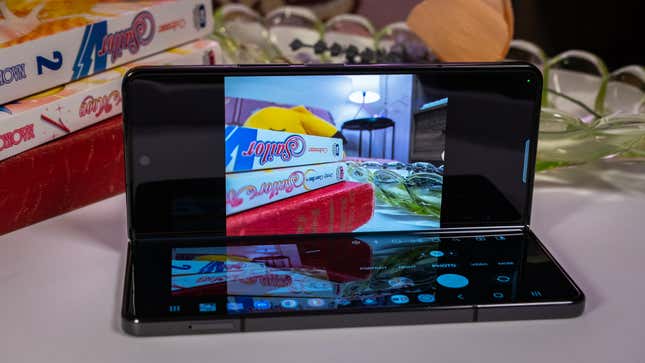
Here’s a breakdown of the camera system on the Galaxy Z Fold 5:
- the primary camera is a 50-MP wide-angle lens with an f/1.8 aperture
- the second camera is a 12-MP ultra-wide camera with a 123-degree field-of-view
- the third camera is a 10-MP telephoto camera with up to 3x optical zoom and up to 30x digital zoom
- the front-facing selfie camera is a 10-MP camera with an f/2.2 aperture
- the inside camera is 4-MP with an f/1.8 aperture
If you think the inside camera sounds paltry after looking at that list, it’s because it is. I understand the 4-MP camera exists mainly for video calls, but it’s middling. I’ve had to apologize to my doctor over Zoom for the camera quality with the Z Fold 4, which was an 8-MP sensor, and I would bet there are more apologies on the horizon for future virtual appointments.

On the bright side, the rest of the Galaxy Z Fold 5 cameras are nothing like that inside camera. I took a few sample selfies between the Z Fold 4 and Z Fold 5’s front-facing cameras, and the latter produced brighter, less yellow-tinged photos. Then I remembered that I love Samsung’s camera app for taking pictures of myself over Google’s because I can use some of the built-in sculpting features to decrease the tiredness on my face.
The triple-array rear camera system has also improved over its predecessor, though it is just a reprise of what’s available on the non-folding Galaxy S23/S23+. Samsung’s photos still skew saturated, but often the array gives the final product a little more life than what the Pixel algorithm produces. Still, for the amount this phone costs, the Z Fold 5 should be able to zoom in farther than it does. The Pixel Fold can reach out up to 5x optical zoom, and while I don’t need the Z Fold 5 to zoom in as far as its sibling, the Galaxy S23 Ultra, I would like to be able to take a picture of a bird far away from my balcony without any jagged edges. The Pixel Fold is also a better camera companion for night-time photography. The Z Fold 5 is fine with landscape shots in the dark, but Google can capture the stars and even produce an animation of their movement.

I was impressed by the stability of the video shot with the Galaxy Z Fold 5. I mounted it on my car dashboard while driving through downtown San Francisco to take footage of the city outside. The Z Fold 5 was shaking on the flimsy mount, but the footage came out mostly balanced and smooth despite that. The result was quite cinematic.
Samsung is still the best at folding software
Samsung is still the best at making folding phone software. It’s not something I ever imagined myself saying because I spent so many years reviewing Android devices and lamenting the brand’s poor software support and interface stylings. But Samsung’s version of Android, dubbed One UI, has changed the narrative over the past few years. It’s also why a Samsung folding phone experience is different from Google’s folding phone experience.
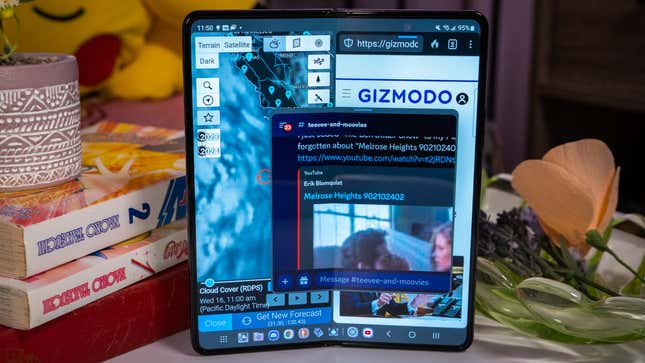
The best part of the Galaxy Z Fold 5’s software is the drag-and-drop mechanism for pinning apps on the screen. From the app switcher window, you can touch and drag an app to the side of the inside screen you want to open it up on. Google’s Pixel Fold doesn’t do this. Instead, Android’s stock interface requires a little more focus, and you have to select the specific option to open the app in split screen mode. It’s unintuitive.
The app dock at the bottom of the main screen on the Z Fold 5 also makes better use of its space. Rather than have the navigation bar on the same row as the app shortcuts, it’s below it on either the right or left side, depending on how you set it up in the settings panel. And once you launch into an app, the dock shrinks down and includes shortcuts for the last two previously opened apps.
The other bummer about the Google Pixel Fold is that there is no built-in desktop mode like on the Z Fold 5. It’s not that anyone necessarily needs to be able to plug in a monitor and peripherals to their smartphone. But considering the starting price of these two devices, I expected them to feature all the marquee capabilities each maker offers. Samsung knows it has something with its DeX desktop mode because people ask for it when it’s not there. I’m still waiting for Google’s equivalent to appear in some capacity.
At the very least, the folding apps ecosystem is getting more expansive as more people adopt the form factor. Android apps work better now with the different screen sizes as Google has improved its suite of apps to work better with these form factors. Even Instagram has finally hopped on with a tablet-style layout that eliminates the letterbox and performs excellently on the Z Fold 5.
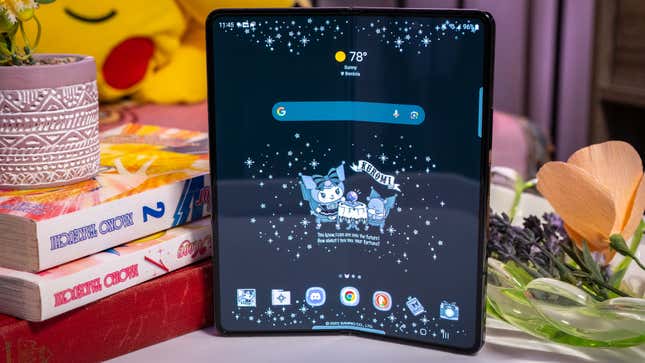
Should you buy the Galaxy Z Fold 5?
At its core, the Galaxy Z Fold 5 is a Galaxy S23/S23+ embedded inside a folding body. The least you can spend on the Galaxy Z Fold 5 before any sales and trade-ins is $1,800 for 256GB of storage. There are also 512GB and 1TB options, which increase the price to nearly $2,200—256GB is adequate space as long as you have the habit of backing up and pruning on-device files.
I said it last year, and I’ll repeat it: Samsung’s Galaxy Z Fold 5 costs too much money. You have to be sincerely committed to Samsung and the foldable lifestyle to drop this much cash on a smartphone that you’ll wield for a few years—and that’s if you can manage not to run into the usual snafus that folding phone owners have been complaining about the last few generations, like cracked screens and dust getting under the inside screen cover. While Samsung has been consistent about software updates—the Z Fold 5, in particular, promises up to five years of security updates, which is longer than Google’s timeline—and making hardware repairs more accessible than before, this is a phone you’ll have to be careful with as you’re carting it around. But at least you’ll have some bragging rights and a device that folds out flatter than ever.

